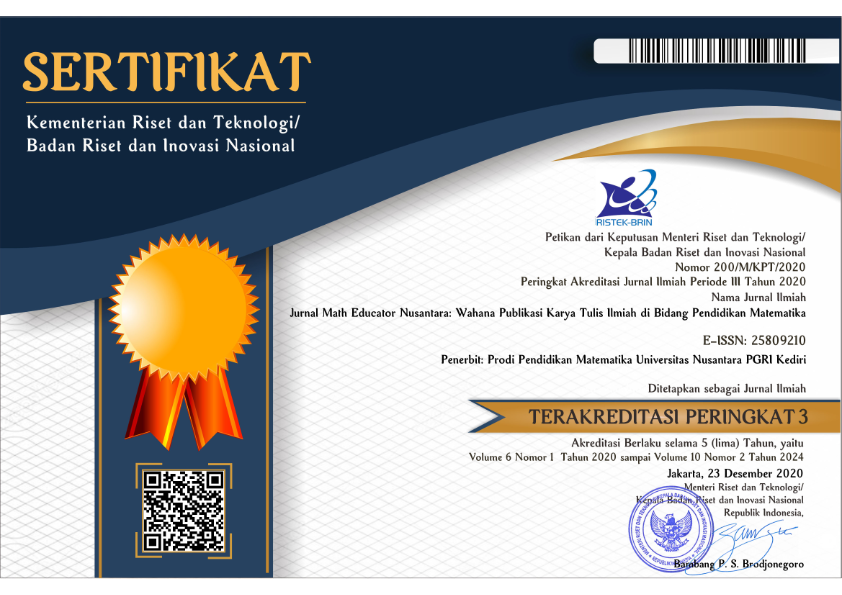Development of hots mathematic problems (higher order thinking skills) Based on Crulic & Rudnick Taxonomy
DOI:
https://doi.org/10.29407/jmen.v7i1.15895Keywords:
HOTS mathematics problem, Formative evaluation, Taxonomy Krulik & RudnikAbstract
The lack of availability of HOTS math questions in the field makes it difficult for teachers to teach students higher order thinking skills. Most of the hots questions developed were based on Bloom's taxonomy revised by Anderson et al. This study aims to produce valid and reliable HOTS questions and to measure students' higher-order thinking skills. This study uses a Tessmer model development research. This development model consists of 2 stages, namely (1) the preliminary stage and (2) the formative evaluation. Instrument testing was carried out in class X MIPA E SMA Negeri 1 Kediri. The data collection instruments included a question grid, a HOTS class X maths question sheet based on Krulik-Rudnick's, a validation sheet, and a question readability questionnaire. The data analysis technique uses item analysis which consists of validity, reliability, level of difficulty, and distinguishing power. This research has produced 11 items that are valid, practical, and reliable. In addition, this study produced a reliable item with a Cronbach's Alpha value of 0.921. The results of the test questions concluded that the high-order thinking skills (HOTS) of class X students in mathematics were good with an average score of 33.17.
References
Abdullah, A. H., Abidin, N. L. Z., & Ali, M. (2015). Analysis of students’ errors in solving Higher Order Thinking Skills (HOTS) problems for the topic of fraction. Asian Social Science, 11(21), 133–142. https://doi.org/10.5539/ass.v11n21p133
Anisah, Zulkardi, & Darmowijoyo. (2011). Pengembangan Soal Matematika Model Pisa Pada Konten Quantity Untuk Mengukur Kemampuan Penalaran Matematis Siswa Sekolah Menengah Pertama. Jurnal Pendidikan Matematika, 5(1), 1–15. Retrieved from https://media.neliti.com/media/publications/121613-ID-pengembangan-soal-matematika-model-pisa.pdf
Arifin, Z. (2012). Evaluasi pembelajaran. Bandung: Remaja Rosdakarya, 425. https://doi.org/979-692-956-2
Arifin, Zaenal, & Retnawati, H. (2017). Developing an Instrument to Measure Mathematics Higher Order Thinking Skills of 10th Grade Student in Senior High School. PYTHAGORAS: Jurnal Pendidikan Matematika, 12(1), 98–108. Retrieved from https://journal.uny.ac.id/index.php/pythagoras/article/view/14058
Brookhart, S. M. (2010). How to assess higher-order thinking skills in your classroom. Journal of Education. https://doi.org/10.1177/002205741808801819
Brookhart, S. M. (2014). How to Design Questions and Tasks to Assess Student Thinking, 142. Retrieved from http://books.google.com/books?hl=en&lr=lang_en&id=YUhTBAAAQBAJ&pgis=1
Cahyani, D. N., Syaban, M., & Ridha, M. R. (2019). Peningkatan Kemampuan Berpikir Kreatif Matematis melalui Pembelajaran Open-Ended pada Siswa SMP. INTERMATHZO: Jurnal Pendidikan Matematika, 4(2), 78–86.
Cayani, S., & Saltifa, P. (2021). Pengembangan soal higher order thinking skill (hots) materi bilangan di sekolah menengah pertama. Jurnal Equation, 4.
Chinedu, C. C., & Kamin, Y. (2015). Strategies for improving higher order thinking skills in teaching and learning of design and technology education. Journal of Technical Education and Training, 7(2), 35–43.
Churches, A. (2007). Bloom’s Digital Technology, 1–11. Retrieved from http://www.ccconline.org/wp-content/uploads/2013/11/Churches_2008_DigitalBloomsTaxonomyGuide.pdf
Collins, R. (2014). Skills for the 21st Century : teaching higher-order thinking. Leadership Journal, 12(14), 1–8.
Conklin, W. (2011). Higher-Order Thinking Skills to Develop 21st Century Learners. Shell Education Publishing Inc. Huntington.
Forehand, M. (2010). Bloom’s Taxonomy. In M. Orey (Ed.), Emerging Perspectives on Learning,Teaching, and Technology (pp. 93–95). Zurich, Switzerland: The Global Text Project is funded by the Jacobs Foundation. https://doi.org/10.4324/9780203422090
Hewi, L., & Shaleh, M. (2020). Refleksi Hasil PISA (The Programme For International Student Assesment): Upaya Perbaikan Bertumpu Pada Pendidikan Anak Usia Dini). Jurnal Golden Age, 4(01), 30–41. https://doi.org/10.29408/jga.v4i01.2018
Johar, R., Yusniarti, S., & Saminan. (2018). The analysis of proportional reasoning problem in the Indonesian mathematics textbook for the junior high school. Journal on Mathematics Education, 9(1), 55–68. https://doi.org/10.22342/jme.9.1.4145.55-68
Katminingsih, Y. (2012). Mengenal revisi taksonomi bloom oleh anderson dan krathwohl. In S. Suryanto (Ed.), Prosiding Seminar Nasional Pengintegrasian Pendidikan Budaya dan Karakter Bangsa. Kediri: LPPM UNP Kediri.
Khan, W. B., & Inamullah, H. M. (2011). A study of lower-order and higher-order questions at secondary level. Asian Social Science, 7(9), 149–152. https://doi.org/10.5539/ass.v7n9p149
Krulik, S., & Rudnick, J. A. (1999). Innovative tasks to improve critical and creative thinking skills. From Developing Mathematical Reasoning in Grades K-12, 138–145.
Kurniati, D., Harimukti, R., & Jamil, N. A. (2016). Kemampuan berpikir tingkat tinggi siswa SMP di Kabupaten Jember dalam menyelesaikan soal berstandar PISA. Jurnal Penelitian Dan Evaluasi Pendidikan, 20(2), 142–155. https://doi.org/10.21831/pep.v20i2.8058
Lewy; Zulkardi; Nyimas Aisyah. (2019). Pengembangan soal untuk mengukur kemampuan berpikir tingkat tinggi pokok bahasan barisan dan deret bilangan di kelas ix akselerasi smp xaverius maria palembang. Jurnal Pendidikan Matematika, 3(2), 14–28.
Lewy, L. (2013). Pengembangan Soal Untuk Mengukur Kemampuan Berpikir Tingkat Tinggi Pokok Bahasan Barisan Dan Deret Bilangan Di Kelas Ix Akselerasi Smp Xaverius Maria Palembang. Jurnal Pendidikan Matematika, 5(1). https://doi.org/10.22342/jpm.5.1.821.
Listiani, D., & Prihatnani, E. (2018). Pengembangan media pembelajaran dart board math bagi siswa kelas VII SMP. Math Didactic: Jurnal Pendidikan Matematika, 4(1), 21–33. https://doi.org/10.33654/math.v4i1.80
Megawati, M., Wardani, A. K., & Hartatiana, H. (2019). Kemampuan Berpikir Tingkat Tinggi Siswa Smp Dalam Menyelesaikan Soal Matematika Model Pisa. Jurnal Pendidikan Matematika, 14(1), 15–24. https://doi.org/10.22342/jpm.14.1.6815.15-24
Muchtadi, M. (2016). BERPIKIR KREATIF. In A. R. As’ari & E. B. Irawan (Eds.), Variasi konstruk dalam pembelajaran matematika. MALANG: CV. Bintang Sejahtera.
Nalurita, I., Sutinah, & Rahaju, E. B. (2005). Profil kemampuan siswa smp dalam menyelesaikan soal hot pada materi lingkaran ditinjau dari kemampuan matematika siswa.
OECD. (2016). Country Note – Results from PISA 2015: Indonesia. Oecd, 1–8. Retrieved from https://www.oecd.org/pisa/PISA-2015-Indonesia.pdf
OECD. (2019). Assessment and Analytical Framework. Chapter 1 What is PISA ? Retrieved from https://pusmenjar.kemdikbud.go.id/tentang-pisa/
Prasetya, I. Y. (2017). Analisis Soal-Soal Buku Ajar Matematika Kelas Vii Ditinjau Dari Taksonomi Bloom Revisi. Tesis. Surakarta: Universitas Muhammadyah.
Rahmawatiningrum, A., Kusmayadi, T. A., & Fitriana, L. (2019). Student’s ability in solving higher order thinking skills (HOTS) mathematics problem based on learning achievement. Journal of Physics: Conference Series, 1318(1). https://doi.org/10.1088/1742-6596/1318/1/012090
Sangpom, W., Suthisung, N., Kongthip, Y., & Inprasitha, M. (2016). Advanced Mathematical Thinking and Students’ Mathematical Learning: Reflection from Students’ Problem-Solving in Mathematics Classroom. Journal of Education and Learning, 5(3), 72. https://doi.org/10.5539/jel.v5n3p72
Tessmer, M. (1993). Planning and conducting formative evaluations: Improving the quality of education and training. Psychology Press.
Widana, I. W. (2017). Modul Penyusunan Soal Higher Order Thinking (HOTS).
Widana, I Wayan. (2017a). Evaluasi Proses dan hasil Belajar. Fakultas Pendidikan Matematika Dan Ilmu Pengetahuan Alam (FPMIPA) INSTITUT Keguruan Dan Ilmu Pendidikan (IKIP) PGRI BALI.
Widana, I Wayan. (2017b). Modul Penyusunan Higher Order Thingking Skill (HOTS). Direktorat Pembinaan Sma Direktorat Jenderal Pendidikan Dasar Dan Menengah Departemen Pendidikan Dan Kebudayaan 2017. Jakarta: Direktorat Pembinaan SMA Ditjen Pendidikan Dasar dan Menengah.
Widodo, S. (2015). Profil Berpikir Kreatif Guru Matematika SMP dalam Membuat Masalah Matematika Kontekstual berdasarkan Kualifikasi Akademik. Disertasi Tidak Dipublikasikan). Universitas Negeri Surabaya.
Widodo, Suryo, & Katminingsih, Y. (2020). Asesmen autentik Berbasis Pendidikan Abad ke-21. (T. Fiktorius, Ed.). Lumajang: Klik Media.
Widodo, T., & Kadarwati, S. (2013). Higher order thinking berbasis pemecahan masalah untuk meningkatkan hasil belajar berorientasi pembentukan karakter siswa. Cakrawala Pendidikan, 32(1), 161–171.
Wulandari, S., Hajidin, & Duskri, M. (2020). Pengembangan Soal Higher Order Thinking Skills ( HOTS ) pada Materi Aljabar di Sekolah Menengah Pertama, 7(2), 200–220. https://doi.org/10.24815/jdm.v7i2.17774
Downloads
Published
Issue
Section
License
Authors who publish with this journal agree to the following terms:
- Copyright on any article is retained by the author(s).
- The author grants the journal, the right of first publication with the work simultaneously licensed under a Creative Commons Attribution License that allows others to share the work with an acknowledgment of the work’s authorship and initial publication in this journal.
- Authors are able to enter into separate, additional contractual arrangements for the non-exclusive distribution of the journal’s published version of the work (e.g., post it to an institutional repository or publish it in a book), with an acknowledgment of its initial publication in this journal.
- Authors are permitted and encouraged to post their work online (e.g., in institutional repositories or on their website) prior to and during the submission process, as it can lead to productive exchanges, as well as earlier and greater citation of published work.
- The article and any associated published material is distributed under the Creative Commons Attribution-ShareAlike 4.0 International License














